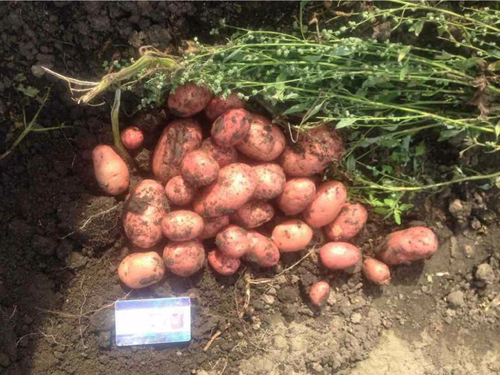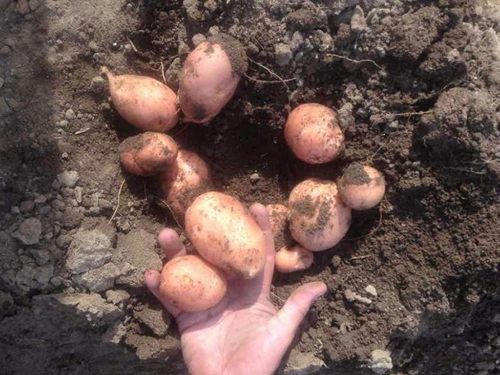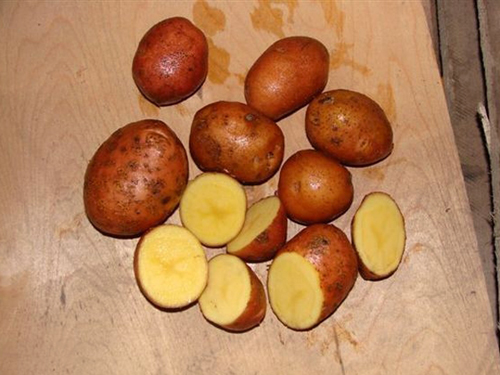Potato variety Rosalind
Rosalind is an early maturing table potato (Solanum tuberosum). Bred by employees of the German company EUROPLANT Pflanzenzucht GmbH. In 2002, it was entered into the state register of breeding achievements of the Russian Federation in the Central Region, but in 2016 it was excluded from it due to the refusal of the originator from the patent. Differs in frost resistance and high marketability. Can produce two crops per season.

The period from germination to harvest is 52-62 days, subject to preliminary germination.
The plant is rather tall, of an intermediate type, the main stem is semi-erect. Leaves are medium in size, open and green in color. Weak or medium waviness is noticeable along the edges of the leaf plate. Flowers usually fall off quickly.
The root system of Rosalind potatoes is well developed, in one nest up to 16 tubers are formed, equal in size. Tubers are oval-rounded, weighing 59-115 grams. The peel is red in color, smooth to the touch. The flesh on the cut has a yellow color, does not darken when cutting and boiling. The eyes are small, superficial.
Marketable yield, according to state tests, on average 203-223 c / ha, 27-59 c / ha higher than the indicators of the variety Zhukovsky early... At the first digging, on the 45th day after full germination, it is possible to collect 89-132 c / ha, 35-42 c / ha more than the standard, and during the second dig, on the 55th day, - 134-181 c / ha , 17−42 c / ha above the norm. The maximum yield was recorded in the Vladimir region - 248 c / ha. Marketability is high - 89−94%, keeping quality - about 94%.

Rosalind belongs to culinary type B (according to the EAPR classification - European Association for Potato Research), that is, the tubers are medium-boiling. Their taste is excellent! Tuber crops are suitable for cooking any dishes, but they are especially good for frying, baking, stuffing, they will perfectly complement soups, vegetable mixes and salads. After heat treatment, the tubers do not lose their shape and pleasant color, which makes them look very appetizing when finished. The starch content in the pulp is about 12.2-17.3%.
The variety is undemanding to the type and composition of the soil, is able to adapt to any climatic conditions. Plants respond very well to watering and feeding and, with not at all complicated care, are able to give a consistently good amount of harvest. One of the main advantages of this potato is its high frost resistance, due to which it can be grown in almost all regions of Russia. Below is a short list of tips and tricks for getting the best yield.
- Pre-germination of tubers is required before planting. This will significantly increase germination and also shorten the growing season. Preventive treatment for pests and diseases, especially late blight, will not be superfluous.
- The optimum distance between the planting holes is 28-30 cm, the row spacing is 70 cm, the planting depth is 8-10 cm. Rosalind can be planted using either the standard method or the Dutch method.

- As already mentioned, plants respond well to watering, moreover, good soil moisture increases their productivity. In the southern regions, mulching can be used to prevent the soil from drying out if you do not have the opportunity to visit your site often. However, the best solution would be to install an automatic irrigation system.
- During the growing season of potatoes, one or two feeding of the plantings should be carried out. The dosage of the applied fertilizers is normalized based on the characteristics of the soil composition.
- It is also necessary to carry out other standard agricultural techniques, such as loosening the soil and hilling, weeding, preventive treatments against pests and diseases.
- It is especially important for this variety to maintain crop rotation due to its susceptibility to late blight. Do not plant tubers where other nightshade crops have previously grown. The best predecessors will be cabbage, cucumber, legumes, zucchini, onions, garlic, green manure, and beets.
Rosalind is resistant to cancer, cyst nematodes and many viruses. However, according to the All-Russian Research Institute of Phytopathology, plants are very susceptible to late blight from tops and tubers, as mentioned above. This is the main drawback of the variety, and, perhaps, that is why the originator refused it. On the other hand, with the observance of preventive measures and the use of high-quality seed material, this problem will not be a decisive factor when choosing this variety for cultivation.
This potato has managed to earn quite a lot of positive reviews. Especially appreciated are its good taste, amicable ripening of tubers, their large number in one nest and uniformity in weight and size, excellent presentation and excellent keeping quality. The main advantage is considered frost resistance, as well as unpretentiousness to growing conditions, a high degree of adaptation to any climatic latitude and various types of soils. The variety does not differ in ultra-high yields, but it is quite stable and always ripens on time. Many gardeners prefer it precisely because of the opportunity to get two crops per season.
Rosalind has practically no flaws, with the exception of susceptibility to the causative agent of late blight. If you are confident in your abilities and know how to protect plants from disease, choosing this variety for growing will be a good decision! But be careful when buying planting material, there is a large number of negative reviews on the network about seed potatoes purchased from some agricultural firms. Often, unscrupulous sellers sell tubers infected with diseases.









I have been growing Rosalind for three years now, always good yield, keeping quality is excellent, taste is above average, I just probably like more starchy varieties. I will say, in my opinion, which is tastier than Luck, but inferior to Bellarose and Andretta. I was surprised to learn that the growing season is 50-60 days, I grew it until September, next season I will try to dig it up early.